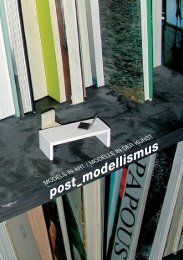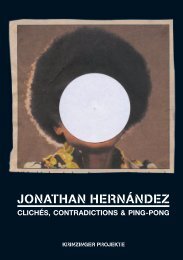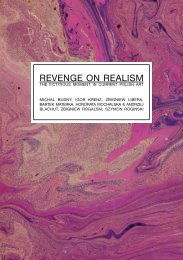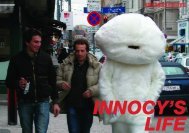Tirol Transfer - krinzinger projekte - Galerie Krinzinger
Tirol Transfer - krinzinger projekte - Galerie Krinzinger
Tirol Transfer - krinzinger projekte - Galerie Krinzinger
Create successful ePaper yourself
Turn your PDF publications into a flip-book with our unique Google optimized e-Paper software.
BEI MIR ZU DIR (WITH ME TO YOU)<br />
– Judith Hopf<br />
ON THE WORKS OF ANGELIKA<br />
KRINZINGER – Peter Weiermair,<br />
Galeria d’Arte Moderna, Bologna<br />
The increasing militarization of our society<br />
and the resulting information transmitted to<br />
us via TV have prompted Stephan Greene<br />
and myself to work on the topic of violence.<br />
In her essay Trauma-TV: Video als Zeugnis,<br />
Avitall Ronell quotes Michael Herr: “Only<br />
through war do we learn to assume responsibility<br />
for everything we have seen<br />
and for everything that we have done. The<br />
problem consisted in the fact that we often<br />
only know what we saw later, sometimes<br />
even years later. (…)”<br />
In the video black snow/low dark we want<br />
to draw attention to a possible shift in perception.<br />
This is an attempt to call into<br />
question our notion of reality and its mutability.<br />
The transmission of violence in the media<br />
and the problem of reversing and omitting<br />
information are addressed in a staged interview<br />
with a dead person in a stylised TV<br />
studio. The video production mainly focuses<br />
on the cultural phenomenon of live<br />
broadcasting that is inherent in TV.<br />
The film adapts the script of a live TV show,<br />
reversing it into a surreal situation. The TV<br />
moderator loses here ostensibly detached,<br />
neutral gaze. She has forgotten her glasses,<br />
she speaks ad-lib, finally proposing a strange<br />
scientific experiment: an interview with<br />
a dead person, the highlight of the TV<br />
show. The dead person who actually appears<br />
as guest in the show does not stick<br />
to the strict interviewing technique but<br />
suggests different levels of conversation.<br />
The moderator increasingly succumbs to<br />
her own thoughts, the show is on the verge<br />
of collapsing.<br />
Angelika <strong>Krinzinger</strong> works with photography,<br />
using its ability to fragment reality,<br />
which Surrealism in particular discovered<br />
for itself as an expression of alienation.<br />
<strong>Krinzinger</strong> isolates certain body parts but<br />
not for documentary purposes as medical<br />
photography does but in a poetic way. In<br />
her portraits, consisting of three pictures,<br />
she thus juxtaposes eye, lips and nipples<br />
of a certain person and only differentiates<br />
details of those body parts that serve an<br />
exchange with the world that is sexual and<br />
erotic but also a functional. Here one individual<br />
opens up to another so that what is<br />
unique about each individual is revealed.<br />
Following the series of comparative portraits,<br />
<strong>Krinzinger</strong> created a series on body<br />
parts where she also captures views of the<br />
body that cannot be perceived by the person<br />
being photographed. Here, too, she<br />
is interested in similarity and difference,<br />
general typology and individual manifestation,<br />
clarity and ambiguity, the reading of<br />
photography and of the body.<br />
71









